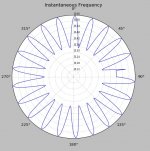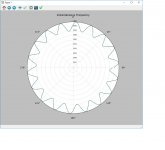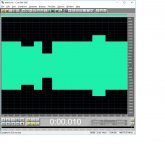OK I can fix the rotational direction and labels easily. So a question, what kind of automation would be useful? Right now the ticks are fixed at 3Hz but the way the code works 1 kHz, 3.15kHz, 3 kHz all work automatically scaled to the max deviation at the same 3Hz per tick. The problem is the totally general oddball Hz per tick gets hard to read, 1Hz for 1kHz and 3Hz for 3K only is easy.
Last edited:
Automation? Ok, must resist giving a bit long spec sheet on what all my wildest dreams are, but in terms of a realtime tool for checking effects of certain adjustments being able to click to sample at any time would be great and the ability to have a side by side (or overlaid) reference vs latest so you can see the effect of the changes. However cut and paste also works well.
But given this is so far ahead of anything previously available it really seems churlish asking for any more 🙂
But given this is so far ahead of anything previously available it really seems churlish asking for any more 🙂
I think a convention of rotation which follows platter direction, clockwise, is intuitive,
If you think about it location wise that's backwards. 🙂
I wonder just how many faulty turntables there are out there. Easily detected with a realtime tool like this is becoming...But given this is so far ahead of anything previously available it really seems churlish asking for any more 🙂
If you think about it location wise that's backwards. 🙂
That is in the frame of reference of the LP the tone arm goes counterclockwise.
If your test record has a visible scratch and then the analysis shows a wobble 1/4 revolution later, then this is anticlockwise of the scratch and it would be better for the polar plot to go the same way
Here's some of the synthetic calibration files:
8Hz@0.1%
12Hz@0.2%
12Hz@0.4%
16Hz@0.1%
Dropbox - Polar plot calibration wav files
For historic reasons these are 22kHz sample rates, so need upsampling.........
Hope this helps - I'll leave them up for a few days.
LD
8Hz@0.1%
12Hz@0.2%
12Hz@0.4%
16Hz@0.1%
Dropbox - Polar plot calibration wav files
For historic reasons these are 22kHz sample rates, so need upsampling.........
Hope this helps - I'll leave them up for a few days.
LD
I wonder just how many faulty turntables there are out there. Easily detected with a realtime tool like this is becoming
It does have the capacity to answer a whole load of questions. It also concerns me that Scott's U-turn keeps showing itself to be almost as good as you need!
The same link now includes a few am and noise rejection test files - HTH !Here's some of the synthetic calibration files:
8Hz@0.1%
12Hz@0.2%
12Hz@0.4%
16Hz@0.1%
Dropbox - Polar plot calibration wav files
For historic reasons these are 22kHz sample rates, so need upsampling.........
Hope this helps - I'll leave them up for a few days.
LD
LD
cant see polar graphs but from the discussion phonosophie looks very good speed stability wise.The Phonosophie No.3 turntable that I have uses a stepper motor with a quadrature oscillator. Aren't stepper motor and synchronous motor the samething?
I posted a 3.15Khz sample tone, see post 30 of this thread (Phonosophie No.3 turntable with Thorens TP90 tonearm and Linn Arkiv B cartridge).
msdin
Link
Last edited:
most enthusiasts in these parts are using vintage classic turntables as is. That is with original bearing/idlers and Direct Drive circuits. It would be interesting to see before and after speed stability measurements of various classic turntables.I wonder just how many faulty turntables there are out there. Easily detected with a realtime tool like this is becoming
Regards.
Last edited:
Many - perhaps most even........ if one defines faulty as having some defect in either config, adjustment, wear, lubrication, etc etc.I wonder just how many faulty turntables there are out there.
IME a tune-up typically makes profound difference to audible pitch stability, and enjoyment of a rig. Even insanely expensive ones........(!)
One needs to know what to tune, though.......and so I wrote my version of polar plot SW for my personal use, to diagnose and tune up my own rigs. The concept, as far as I know, first came from Paul over on pink fish. As often it seems with vinyl playback, what it exposes is both enlightening and surprising..........
LD
Here's some of the synthetic calibration files:
8Hz@0.1%
12Hz@0.2%
12Hz@0.4%
16Hz@0.1%
Dropbox - Polar plot calibration wav files
For historic reasons these are 22kHz sample rates, so need upsampling.........
Hope this helps - I'll leave them up for a few days.
LD
Have all the time in the world today, I'll get on it.
It does have the capacity to answer a whole load of questions. It also concerns me that Scott's U-turn keeps showing itself to be almost as good as you need!
For me, yes. I'm doing this in part to get around to measuring it, I'll bet the numbers are pretty mundane.
What Python version are you using Scott? Your code screenshot from a few days ago is starting to work for me in Python3
What Python version are you using Scott? Your code screenshot from a few days ago is starting to work for me in Python3
Python 2.7.12 |Anaconda 4.1.1 (32-bit)| (default, Jun 29 2016, 11:42:13) [MSC v.1500 32 bit (Intel)] on win32
I have too many old scripts and I'm happy that everything keeps working. When I finish tweaking I'll post the whole thing.Thanks to google I figured out how to insert the degree sign into the tick labels. i do this as a hobby so my programming style can be a bit brutish.
Last edited:
LD the AM rejection is the one I was most worried about, from looking at the file I get about 34dB or 50 to 1. For the problem at hand this would seem good enough, what do you think? Still working on the glitch at the start and getting the waveform to conform to the new direction. I'll get around to the rest and add the file name to the plot somewhere.
Attachments
Last edited:
Did a sanity check using CoolEdit's tone generator and did not find an AM problem. I'm a little puzzled here.
CE has built in FM so here is 6Hz amplitude at 10Hz looks perfect but there is no change with the amplitude steps???
BTW the glitch was the fliter applied suddenly to the mean(3000) of the frequency so I removed the mean and add it back after the filter. The residual is pretty small.
CE has built in FM so here is 6Hz amplitude at 10Hz looks perfect but there is no change with the amplitude steps???
BTW the glitch was the fliter applied suddenly to the mean(3000) of the frequency so I removed the mean and add it back after the filter. The residual is pretty small.
Attachments
All seems well, Scott - the AM rejection seems fine and very good.I'm a little puzzled here.
The file 3k1205am.wav has a 3150Hz tone FM modulated by a 12Hz sine tone with an FM amplitude of 0.5%, and the result is then AM modulated by a sine tone at 4Hz to a depth of 50%.
So your polar plot in post #398 of that file correctly displays the 12Hz 0.5% FM modulation, and shows no sign of the (quite deep) 4Hz AM modulation.
This is good, and correct - bodes well (!)
Another, simpler, test is 3kAm.wav - which has a pure 3150Hz tone deeply AM modulated by a 4Hz sine tone.
HTH!
LD
Last edited:
- Home
- Source & Line
- Analogue Source
- Turntable speed stabilty


